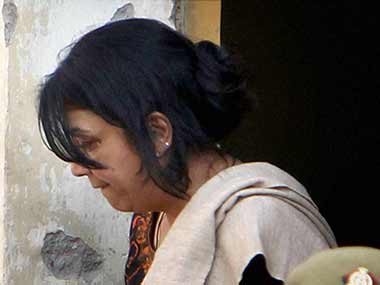New Delhi: The special CBI court in its 204-page judgement convicting Rajesh and Nupur Talwar of murdering their daughter Aarushi and domestic help Hemraj in May 2008 dismisses the defence’s alternate hypothesis that there were seven and not four people in the house on that night as ‘wild suggestions’. [caption id=“attachment_1252277” align=“alignleft” width=“380”]  Aarushi Talwar’s mother Nupur leaves the court after being sentenced to life imprisonment. PTI[/caption] Rajesh’s then compounder at his dental clinic Krishna Thadarai along with Vijay Mandal (domestic help of one of the neighbours) and Raj Kumar (domestic help of the Durranis family friends of the Talwars) had been arrested by the CBI a month after the murders were committed but were subsequently released for lack of evidence. On the defence’s arguments that there was enough evidence to point to the involvement of the three servants judge in his verdict states, “Like a drowning man catching at the straw, wild suggestions have been thrown that there was a possibility of the murder of both the deceased having been committed by these three erstwhile accused and thus alternative hypothesis of commission of double murders by Krishna, Rajkumar and Vijay Mandal stands proved and ex consequenti, the accused deserve to be acquitted. I do not find any substance in the aforesaid submissions.” The special CBI judge chose to disregard CBI’s submissions to court during investigations on the involvement of the servants. On those controversial submissions, the judge says, “If while moving applications for granting police remand of these three erstwhile accused it was mentioned that these persons were involved in the crime then it cannot be held that, in fact, these persons were the perpetrators of the crime because, in practice, the investigating agency when moves application for police remand of an accused then all-out efforts are made to convince the concerned judicial magistrate regarding the complicity of the accused… It is also pertinent to mention here that investigation at that stage was at preliminary stage and all the cumulative evidence and circumstances had not surfaced by then.” The judge also disregarded the testimony of the CBI officer Vijay Kumar in which he said that in Krishna’s brain mapping test, narco analysis test and polygraph test his complicity in double murders had been found. Observing that such tests had no ’legal significance’, the judge states, “It has been held that the results of Brain Mapping, Narco Analysis and Polygraph Tests cannot be admitted in evidence and the results obtained from such tests cannot be categorized as material evidence… In view of the law settled by the Supreme Court, if the erstwhile accused persons had given any inculpatory statements during the course of these tests then they are of no legal significance.” On the two calls made by Krishna to Hemraj on eve of the murders between 4.50 pm and 5.40 pm on 15 May, 2008 (the murders were committed on the intervening night of May 15-16, 2008), the judge says, “One should not lose sight of the fact that Hemraj was also murdered in the intervening night of 15/16.05.2008 and therefore, conspiracy between Hemraj and Krishna cannot be deduced by any stretch of imagination. There is no evidence that Rajkumar and Vijay Mandal were in contact either with Hemraj and Krishna.” Retired Uttar Pradesh police officer K K Gautam’s testimony on the possibility of people in Hemraj’s room on the previous night is describes by the judge as mere “speculation”. On Gautam’s testimony, the judge says, “It was observed (by Gautam) that three persons might have been sitting in the bed as there were depressions on the bed and in the two glasses substance like alcohol was seen and it seemed that toilet of Hemraj had not been flushed and more than one person had urinated in the toilet hardly inspires confidence as this statement is based on surmises, conjectures and speculations. It is not possible at all that in the midnight around 12.00 O’clock Krishna, Rajkumar and Vijay Mandal will come to the room of Hemraj and have liquor drinks.” The judge then goes on to make an assumption. “Since the occurrence is nocturnal inside the flat and the crime came into light in public domain in the morning of 16.05.2008 and therefore, it is possible in all human probability that both the accused may have created evidence of such a nature which may confuse the investigators.” And to justify this assumption, the judgment attempts to connect the ’liberal atmosphere’ at the Talwar household to Rajesh’s attempt to frame the servants. “Accused Rajesh Talwar has admitted.. that he and his wife have been brought up in a very liberal atmosphere with modern outlook and has stated that he takes alcohol at parties… It is also possible that Sula wine may have also been taken by the accused when he was extremely and intensely in tension after committing the crime or it was partly made empty to show that Hemraj and his friends had consumed the liquor.”
The special CBI court dismissed the defence’s alternate hypothesis that there were seven and not four people in the house on that night as ‘wild suggestions’.
Advertisement
End of Article


)

)
)
)
)
)
)
)
)



